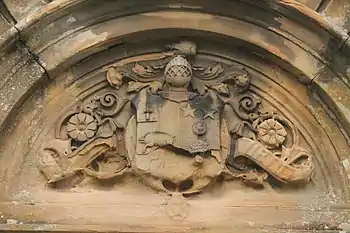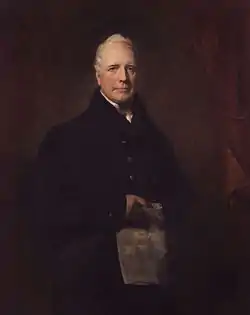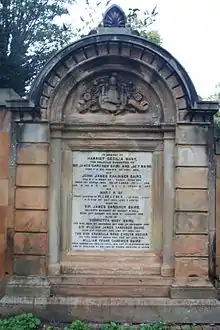Baird baronets
There have been five baronetcies created for persons with the surname Baird, three in the Baronetage of Nova Scotia and two in the Baronetage of the United Kingdom. Three of the creations are extant as of 2010. The Baird Baronets of Newbyth (created in 1660, 1680 and 1809) and of Sauchtonhall (created in 1695) are all descended from Andrew Baird who acquired lands at Auchmedden, Aberdeenshire, in 1539. The main line, Baird of Auchmedden expired on the death in 1777 of Sir William Baird whose Auchmedden estate was forfeit and sold following his involvement in the Jacobite Rising of 1745.


The Baird Baronetcy, of Newbyth in the County of Haddington, was created in the Baronetage of Nova Scotia in 1660 for John Baird, son of James Baird, a younger son of the Baird family of Auchmedden. He was the son of Sir John Baird, a Lord of Session as Lord Newbyth, eldest son of James Baird. Charles I intended to make James Baird a peer as Baron Devern, but he died before the patent had passed the Great Seal. The first Baronet bought an estate at Byth in Aberdeenshire and later moved to Haddington where he established a new settlement which he named Newbyth. Like his father he was a Scottish judge styled Lord Newbyth. He was succeeded by his son, the second Baronet. He had already been created a baronet in his own right, of Newbyth in the County of Haddington, in the Baronetage of Nova Scotia, on 4 February 1680. His son, the second and third Baronet, sat as Member of Parliament for Midlothian. The title became extinct on his death in 1745. The Newbyth estate passed to his cousin William Baird of the Sauchtonhall branch of the family, father of Sir David Baird, 1st Baronet, of the 1809 creation (see below). See also the Baird Baronetcy of Sauchton Hall below.
The Baird Baronetcy, of Saughton Hall (or Saughtonhall or Sauchtonhall) in the County of Edinburgh, was created in the Baronetage of Nova Scotia on 28 February 1695 for Robert Baird, son of James Baird of Auchmedden and brother of Sir John Baird, 1st Baronet, of Newbyth, of the 1660 creation. The title was created with remainder to the heirs male of his body. Baird was an Edinburgh merchant. The fourth Baronet died from wounds received at the Battle of Fontenoy in 1745. The fifth Baronet was a Captain in the Royal Navy. He married Frances, daughter of Colonel James Gardiner.
Philip Beard, son of Charles Baird, younger son of the second Baronet, assumed the surname of Beard. His descendant Edmund Charles Beard was a Major-General in the British Army.
The Baird Baronetcy, of Newbyth in the County of Haddington, was created in the Baronetage of the United Kingdom on 13 April 1809 for the soldier David Baird, grandson of William Baird, a younger son of Sir Robert Baird, 1st Baronet, of Sauchtonhall. His father William Baird had inherited the Newbyth estate in 1745 on the death of Sir John Baird, 3rd Baronet, of the 1660 and 1680 creations. The baronetcy was created with remainder to Baird's elder brother Robert Baird and the heirs male of his body. Baird died childless and was succeeded according to the special remainder by his nephew David Baird, the second Baronet. As a descendant of Sir Robert Baird, 1st Baronet, of Saughton Hall, the present Baronet of Newbyth is also in remainder to this title.
Patrick Baird (died 1816), brother of the first Baronet, was a Major-General in the British Army. Wynn Baird (1799–1835), younger brother of the second Baronet, was a Captain in the Royal Navy. Sir John Baird, second son of the second Baronet, was an Admiral in the Royal Navy.
The Baird Baronetcy, of Urie, was created in the Baronetage of the United Kingdom on 8 March 1897. For more information on this creation, see Viscount Stonehaven.
Baird baronets, of Newbyth; First and second creations (1660/1680)

- Sir John Baird, 1st Baronet (1620–1698)
- Sir William Baird, 1st and 2nd Baronet (1654–1737)
- Sir John Baird, 2nd and 3rd Baronet (1686–1745)
Baird baronets, of Newbyth; second creation (1680)
- see the 1660 creation above
Baird baronets, of Saughton Hall (1695)



- Sir Robert Baird, 1st Baronet (died 1697)
- Sir James Baird, 2nd Baronet (died 1715)
- Sir Robert Baird, 3rd Baronet (c. 1690–1740)
- Sir David Baird, 4th Baronet (c. 1729–1745)
- Sir William Baird, 5th Baronet (d. 1771)
- Sir James Gardiner Baird, 6th Baronet (d. 1830)
- Sir James Gardiner Baird, 7th Baronet (1813–1896)
- Sir William James Gardiner Baird, 8th Baronet (1854–1921)
- Sir James Hozier Gardiner Baird, MC,[2] 9th Baronet (1883–1966)
- Sir James Richard Gardiner Baird, MC,[3] 10th Baronet (1913–1997)
- Sir (James) Andrew Gardiner Baird, 11th Baronet[4] (born 1946)
The heir apparent to the baronetcy is Alexander Baird of Saughtonhall, the Younger (born 1986)
Baird baronets, of Newbyth; third creation (1809)
- Sir David Baird, GCB, 1st Baronet (1757–1829)
- Sir David Baird, 2nd Baronet (1795–1852)
- Sir David Baird, 3rd Baronet DL (1832 – 12 October 1913). Born in Prestonkirk, East Lothian, Baird succeeded his father in the baronetcy as the eldest surviving son in 1852. He served as an officer with the 74th Regiment of Foot in the Xhosa Wars of 1851 and 1852; in the Crimean War, and was on Lord Clyde's staff during the Indian Mutiny. He was subsequently a Captain in the 98th Regiment of Foot, and was promoted Major. He was a member of two famous London clubs: the Army and Navy Club, and White's Club. Baird was also Deputy Lieutenant for the counties of East Lothian and Midlothian. He married, Ellen, daughter and heiress of Charles Stuart, 12th Lord Blantyre, in 1864. At the turn of the century they inherited Lennoxlove near Haddington and settled Newbyth House upon his son and heir David Baird (1865).
- Sir David Baird, MVO, 4th Baronet (1865–1941)
- Sir David Charles Baird, 5th Baronet (1912–2000)
- Sir Charles William Stuart Baird, 6th Baronet[4] (born 1939)
- The heir presumptive is Andrew James Baird (born 1970), a great-great-great grandson of the elder brother of the first baronet.
Baird baronets, of Urie (1897)
Notes
- http://www.cracroftspeerage.co.uk/online/content/Curr%20Scots%20Barts.htm
- Lundy, Darryl. "p. 12920 sec. 129196". The Peerage.
- Lundy, Darryl. "p. 12920 sec. 129190". The Peerage.
- "Official Roll of the Baronetage". Standing Council of the Baronetage. Retrieved 18 December 2019.
References
- Kelly's Handbook to the Titled, Landed & Official Classes for 1903, 29th edition, London, 1903, p. 108.
- Kidd, Charles, Williamson, David (editors). Debrett's Peerage and Baronetage (1990 edition). New York: St Martin's Press, 1990,
- Leigh Rayment's list of baronets